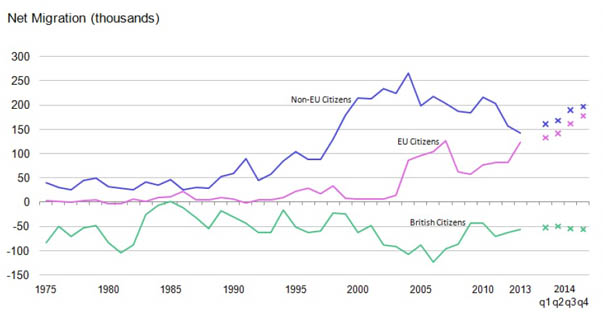David Cameron has announced a package of new measures designed to “control and reduce immigration”, to be unveiled in the new government’s first Queen’s Speech.
The Prime Minister’s speech came on the same day that official migration statistics show the Conservatives are still failing in their ambition of cutting net migration to the tens of thousands.
A bold new policy – or a distraction from the bad news? Let’s take a look.
“Uncontrolled immigration means too many people entering the UK legally but staying illegally.”
The Prime Minister obviously thinks this is a big problem, but the Home Office actually says it doesn’t have any statistics on how many of these people are living in Britain.
John Vine, the last independent chief inspector of borders and immigration, found that the department did have some figures relating to immigrants who stay too long, but could not provide him with complete data.
In his last report in 2014, the outgoing inspector noted that over-stayers who fail to report to the Home Office are supposed to be recorded as “absconders” and their details should ultimately be passed on to police and immigration enforcement officers.
But staff told the watchdog that this was not happening in practice, and there was a backlog of around 10,000 over-stayers in London alone who had not been classed as absconding from immigration control.
The Home Office came up with partial statistics on how many people had been classed as an “absconder” but not recorded as such on the police national computer – 1,100 over a six-month period.
The inspector concluded from this that there were probably more than 10,000 such cases in London. This means known illegal migrants might come into contact with the police, but a computer check would not identify them as over-stayers.
His report made for uncomfortable reading for the government: “Thousands of cases were not being actioned in accordance with the absconder policy… widespread confusion among staff about the absconder policy… large backlog of cases…”
It concluded that the Home Office was “not currently resourced” to meet the challenges of a new crackdown on irregular immigration.
“Addressing the spike in EU migration by renegotiating in Europe.”
It’s not clear what spike he’s talking about here. There certainly was a surge in EU immigration after 2004, as this ONS graph shows:
And immigration from inside and outside Europe have both risen in the last year.
But EU immigration alone does not explain the Conservatives’ failure to meet their target of getting net migration below 100,000 a year in the last parliament.
Today’s stats show net migration from outside the EU alone was 197,000 last year – higher than the figure from EU countries.
There was a net loss of 56,000 British nationals in 2014, so even if you take Europe out of the equation completely – if you pretend it doesn’t exist – we still have more total net migration than the Conservatives want.
“We also recognised that we needed to reduce the demand for migrant labour by making our own people able and willing to do the jobs this country needs. And with 2 million more apprenticeships, radical welfare reform, and a system where it pays to work, we are getting there.”
This might give the impression that apprenticeships created so far have only trained “our own people”. But they are open to EU migrants too.
This was a point made the Conservative skills minister Matthew Hancock in 2013 while attacking Labour’s plans to force businesses to hire more British apprentices.
He said: “I have been advised by Government lawyers that legislating to require hiring British apprentices would be contrary to EU law.”
“There were times under Labour when 90 per cent of job growth was taken up by foreign nationals – under us, the majority of the rise in employment – a record 1,000 jobs for every day we’ve been in office – has gone to Brits.”
It’s possible to quibble with Mr Cameron’s use of language here. The official employment figures don’t strictly show “job growth”. They measure the flows of people in and out of employment.
Nevertheless, the government likes to talk about the rise of employment “under us” (including the coalition period, that is) and what proportion is attributable to UK and non-UK nationals.
Since the 2010 election, there are 1,279,000 more Britons in employment and 805,000 more non-UK nationals. That’s 61 per cent British or “the majority of the rise in employment”.
If we just look at the last year, things are different. Now the rise in employment among non-British nationals is slightly higher – an increase of 294,000 compared to 274,000. And of course the non-UK group is much smaller to start with.
Since the first quarter of 2010, the employment rate for UK nationals has grown from 70.4 to 73.6 per cent. Among the non-UK population the rate has grown more quickly, from 65.4 to 70.5 per cent.
“Dealing with those who shouldn’t be here, by rooting out illegal immigrants and boosting deportations.”
The first of the “big three” points the new strategy will hinge on, according to the Prime Minister.
The latest statistics, covering the year ending September 14, show there were 12,461 “enforced removals” – the lowest number on record.
Just over 15,000 would-be immigrants were “refused entry at port” – less than half the 2009 figure.
Only “voluntary departures” have risen since 2010.




